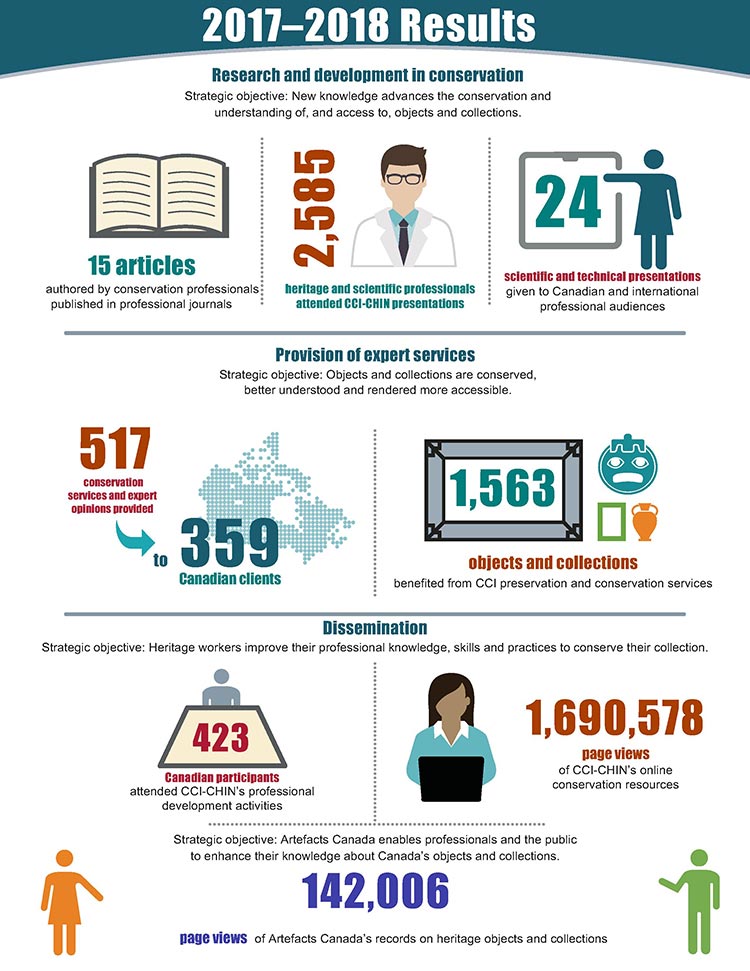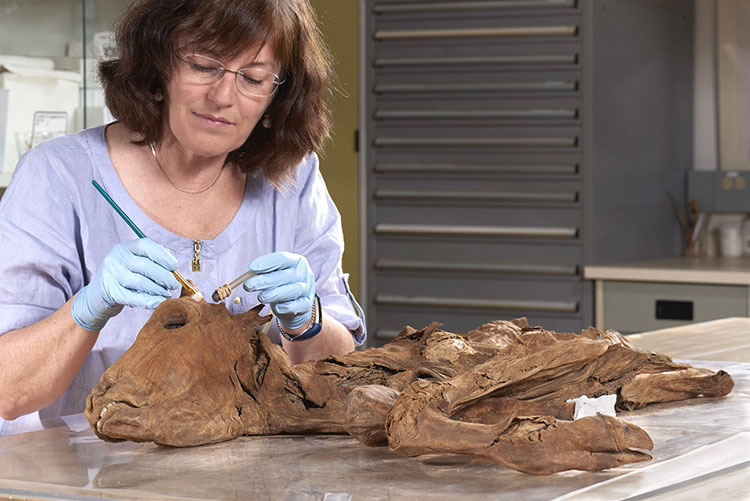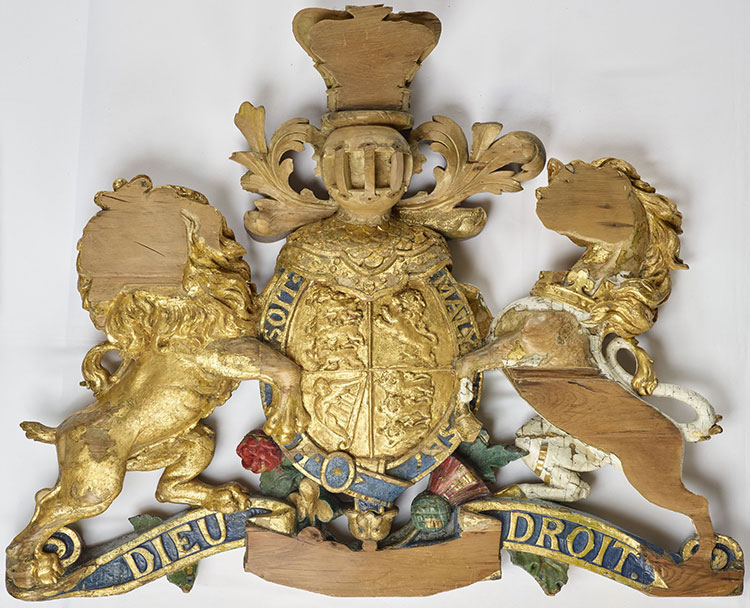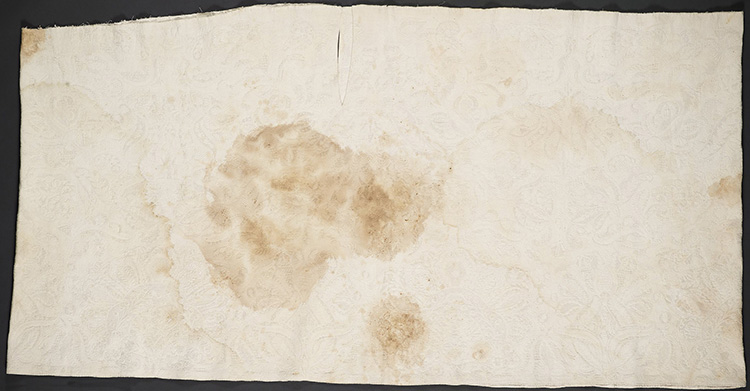2017–2018 Canadian Conservation Institute and Canadian Heritage Information Network Annual Review
On this page
- CCI’s mission
- CHIN’s mission
- Director General’s message
- CCI-CHIN results
- Highlights in 2017–2018
- Treatment of an ice-age mummified caribou calf
- Treatment of a coat of arms from the Parliament of the United Province of Canada
- Stain reduction on a rare 18th-century petticoat
- Preparing for the relocation of paintings in the Senate Chamber
- New preventive conservation resources available online
- Publication of “Collections Management in Canadian Museums: 2016 Results”
- CCI’s video gallery
- External publications
- Financial statements for 2017–2018
CCI’s mission
The Canadian Conservation Institute (CCI) advances and promotes the conservation of Canada’s heritage collections through its expertise in conservation science, treatment and preventive conservation. CCI works with heritage institutions and professionals to ensure these heritage collections are preserved and accessible to Canadians now and in the future.
To achieve its mission, CCI organizes its operations into three core activity areas:
- Research and development in conservation, including scientific research, advanced techniques for treatment and restoration, and practical and innovative solutions for caring for collections
- Provision of expert services, including scientific services, conservation treatments and preservation advisory services, to heritage institutions and professionals
- Sharing of conservation knowledge, through training, professional development, online learning materials and publications, to assist those responsible for heritage objects and collections in making informed decisions about the care of their collections
CHIN’s mission
The Canadian Heritage Information Network (CHIN) assists Canadian museums in documenting, managing and sharing information about their collections to ensure that this information is accessible now and in the future.
To achieve its mission, CHIN organizes its operations into three core areas of activity:
- Create and maintain an online point of entry to Canadian collections
- Carry out research and development on collections documentation tools and standards
- Provide guidance and training to cultural institutions on managing collections information
Director General’s message

As the new Director General of the Department of Canadian Heritage’s Heritage Group, which includes CCI and CHIN, I am pleased to share with you the 2017–2018 Canadian Conservation Institute and Canadian Heritage Information Network Annual Review. The year spanning 2017 to 2018 coincided with Canada’s sesquicentennial, and we celebrated the occasion with a variety of projects uniquely suited to the commemoration. CCI concluded the treatment or analysis of a series of objects that were at the heart of exhibitions marking Canada 150, such as the Maurice “Rocket” Richard hockey jersey from the Canadian Museum of History in Gatineau, Quebec, and the Victory Loan Campaign Honour Flag from the Peel Art Gallery, Museum and Archives in Brampton, Ontario. We also gave more of our fellow Canadians the opportunity to see the work we do and to better understand the importance of conserving Canada’s treasures by expanding our annual open house to two full days.
Throughout the year, CCI and CHIN staff continued to deepen their working relationship, identifying new opportunities for collaboration. The impact of this collaboration on the heritage community can be clearly demonstrated by the number of page views for CCI-CHIN resources: in 2017–2018, nearly 1,700,000 web pages were consulted. These views helped heritage institutions in Canada and abroad preserve and manage their heritage collections and objects.
In keeping with its mandate, CHIN drew on lessons learned through two ambitious pilot projects and began a multi-year project to modernize Artefacts Canada, Canada’s national inventory of museum objects. The modernization is based on a semantic web approach and linked open data model, providing Canadians with the opportunity to discover new themes and relationships linking Canada’s treasures and the creators behind them.
CCI continued to focus its activities around the directions set in its 2015–2020 Strategic Plan. Among its accomplishments, CCI:
- initiated the consultations that will inform its approach to researching and treating modern materials in future years,
- started new research and published updated and new resources related to modern information carriers and digital preservation,
- completed the Quebec phase of RE-ORG: Canada and proceeded to take this training and network-building initiative to the Prairies and North, and
- continued to contribute its expertise in the conservation of heritage interiors for the purposes of the rehabilitation of the Centre Block within the Parliamentary Precinct.
Soon, our attention will turn to developing a follow-up strategic plan to guide us into the next decade; as well, CCI and CHIN’s integration will continue to deepen with the inclusion of digital heritage objectives.
As we look ahead, establishing a path towards a suitable replacement for CCI’s aging facility will continue to be a priority. We are engaging potential partners with similar needs to ensure CCI-CHIN can continue to support Canada’s heritage institutions for decades to come.
Jérôme Moisan
Director General
Heritage Group
CCI-CHIN results

Infographic description
CCI-CHIN results by core activity area for 2017–2018
Research and development in conservation
Strategic objective: New knowledge advances the conservation and understanding of, and access to, objects and collections.
Results:
- 15 articles were authored and published by conservation professionals in specialized journals
- 2,585 heritage and scientific professionals attended CCI-CHIN presentations
- 24 scientific and technical presentations were given to Canadian and international professional audiences
Provision of expert services
Strategic objective: Objects and collections are conserved, better understood and rendered more accessible.
Results:
- 517 conservation services and expert opinions provided to 359 Canadian clients
- 1,563 objects and collections benefited from CCI preservation and conservation services
Dissemination
Strategic objective: Heritage workers improve their professional knowledge, skills and practices to conserve their collection.
Results:
- 423 Canadian participants attended CCI-CHIN’s professional development activities
- 1,690,578 page views of CCI-CHIN’s online conservation resources
Strategic objective: Artefacts Canada enables professionals and the public to enhance their knowledge about Canada’s objects and collections.
142,006 page views of Artefacts Canada’s records on heritage objects and collections.
Highlights in 2017–2018
Treatment of an ice-age mummified caribou calf
CCI undertook the conservation treatment of an ice-age mummified caribou calf that was found in an 80,000-year-old volcanic ash bed known as the Dominion Creek tephra, located in the Yukon. While the calf could be as old as the ash bed, radiocarbon dating can only confirm that it is more than 50,000 years old, which is the limit for this technology. Radiography was used to reveal the calf’s skeleton and internal organs, which identified it as a male specimen. Tara Grant, Senior Conservator, Archaeological Materials, chose to carry out a minimalist treatment to avoid introducing chemicals that might affect future analysis. The calf was cleaned with reverse osmosis water and a soft brush, and then it was frozen and freeze-dried without a bulking agent. Any remaining dirt that was visible after drying was removed by brushing and vacuuming through a nozzle covered with screening. Now conserved and ready for exhibition, this unique specimen was safely shipped to the Paleontology Program of the Yukon Department of Tourism and Culture.

© Government of Canada, Canadian Conservation Institute. CCI 129498-0064
Figure 1. Cleaning, with a brush and a vacuum, the head of the caribou calf recovered from a permafrost archaeological site in the summer of 2016.
Treatment of a coat of arms from the Parliament of the United Province of Canada
CCI completed the conservation treatment of the Royal Coat of Arms of the United Kingdom of Great Britain and Ireland, which belongs to Pointe-à-Callière, the Montréal Archaeology and History Complex. This coat of arms is purported to have been displayed over the Speaker’s Chair in the Legislative Assembly of the United Province of Canada. This unified colony existed between 1841 and 1867 and included parts of what are now Ontario, Quebec and Labrador.
Sculpted in wood, painted and gilded, the coat of arms was rescued from the burning Legislative Assembly in Montréal in the aftermath of the riots that devastated the building in 1849. Following structural repairs, analyses of the remaining decorative layers helped to identify original surfaces and to establish a history of repainting and restoration. In some areas, original surfaces were exposed and restored as needed. Missing pieces, lost over the years, such as the heads of the lion and unicorn, were not replaced in order to maintain the historical integrity of the object.

© Government of Canada, Canadian Conservation Institute. CCI 124848-0132
Figure 2. The Royal Coat of Arms of the United Kingdom of Great Britain and Ireland, after treatment.
Stain reduction on a rare 18th-century petticoat
CCI Senior Conservation Scientist Season Tse was approached by the Royal Ontario Museum (ROM) to plan and help execute the treatment of a rare white French petticoat, because of her expertise in stain reduction for historical paper and textiles. The petticoat, dated circa 1740–1750 and quilted in the Marseille embroidery technique with intricate motifs, was structurally in good condition but had large disfiguring, acidic stains. The petticoat could not be exhibited in this condition and was at high risk of embrittlement because of the acidity. Staff members at CCI collaborated with ROM staff specialized in the conservation of textiles to carry out this complex treatment, which succeeded in improving the long-term stability of the textile, as well as in significantly reducing the stains.


Preparing for the relocation of paintings in the Senate Chamber
CCI’s ongoing collaboration with other federal government departments in the rehabilitation of Parliament’s Centre Block included a detailed examination of eight monumental paintings, which have hung in the Senate Chamber since 1921. Their current condition and the causes of deterioration were assessed in order to determine the measures needed to properly protect them when they are relocated from the Senate Chamber. These paintings are among the 1000 works commissioned by Sir William Maxwell Aitken (Lord Beaverbrook) for the Canadian War Memorials Fund. They are now safeguarded by their owner, the Canadian War Museum.

© Government of Canada, Canadian Conservation Institute. CCI 130621-0078
Figure 4. View of three of the four paintings on the east wall in the chamber of the Senate of Canada.
New preventive conservation resources available online
Important new resources in the realm of preventive conservation were published online. Technical Bulletin 32 Products Used in Preventive Conservation became available for free as an online resource or for purchase in hard copy. This new Technical Bulletin provides a critical review of products typically used for the display, storage and transportation of objects by explaining how certain products can affect objects and their preservation, and it proposes guidelines for minimizing damaging effects.
In addition, PadCAD (version 3.0), which museums have used to design protective cushions for the shipment of fragile objects, can now be easily accessed online. Based on commercial cushion design methods and data, the calculator eliminates the need to interpret numerous graphs and perform repetitive calculations to predict the effectiveness of cushion designs. While protective cushioning is key to a successful package, it should be noted that PadCAD and the cushioning curves it uses are predictive design tools.
Publication of “Collections Management in Canadian Museums: 2016 Results”
CHIN published the findings from a 2016 survey on the state and digitization of collections documentation and digital preservation planning in Canadian museums. Results indicated that although a high percentage of respondents are using electronic systems to document their collections, there is room for improvement in terms of standards followed as well as in digital preservation planning. After publishing Collections Management in Canadian Museums: 2016 Results, CHIN developed new tools to help meet the needs of respondents. Ensuing activities include the collection and publication of up-to-date information on collections management systems through a vendor survey, the creation of a template to help develop a request for proposals for a collections management system, and online demos of the products, which have been evaluated by volunteers from the museum community.
CCI’s video gallery
CCI launched a video gallery on its website, posting over 27 didactic and conservation treatment videos that have since attracted thousands of views. The videos not only offer practical advice about issues and questions related to the care, handling and storage of cultural objects, but also provide a behind-the-scenes look at select conservation treatments. The public was invited to share their suggestions and ideas for future videos in the comments section of CCI’s YouTube channel. Two videos, “The Salzinnes Antiphonal” and “The Materials and Techniques of J.E.H. MacDonald,” were even featured in two Canadian art galleries: the Art Gallery of Nova Scotia and the McMichael Canadian Art Collection, respectively.
External publications
The 2 books and 13 articles below were written or co-written by the 15 CCI scientists and conservators identified in bold and were published externally by professional journals and international organizations.
Webster-Cook, Sandra, Kate Helwig and Lloyd DeWitt. “The Research and Conservation Treatment of Jar of Apricots/Le bocal d’abricots, 1758 by Jean-Siméon Chardin.” In B. Buckley, ed., The American Institute for Conservation Paintings Specialty Group Postprints, vol. 26. Washington, D.C.: Paintings Specialty Group of the American Institute for Conservation of Historic and Artistic Works, 2013, pp. 1–19.
Dignard, Carole, Season Tse, Sonia Kata and Jennifer Poulin. “A Comparison of Ethanol and Methanol Vapour Treatments for Reshaping Birch Bark.” In J. Bridgland, ed., ICOM-CC 18th Triennial Conference, Copenhagen, 4–8 September, 2017: Preprints. Paris, France: International Council of Museums, 2017.
Duguay, Dominique, Jane Sirois, Melanie Raby and Isabelle Paradis. “Characterization of Artificial Stone Used for Outdoor Monuments and Sculptures in Quebec.” Journal of the Canadian Association for Conservation, 41 (2016), pp. 3–18.
Dunn, Heather. “Collections Management Software Criteria Checklist.” In S. Yeh and K. Hsiao, eds., Technology Adoption and Digital Opportunities in Museums. Kaohsiung, Taiwan: National Science and Technology Museum, 2017, pp. 69–90.
Dunn, Heather. “Using CIDOC CRM and Linked Open Data to Modernize Artefacts Canada.” International Council of Museums (ICOM) International Committee for Documentation (CIDOC) Newsletter 2016 (PDF format), 2018, pp. 28–33.
Helwig, Kate, Tara Grant, Jane Sirois, Michael Wayman, Gregory Young, Jennifer Poulin and Valery Monahan. “Examination and Analysis of the Kwädąy Dän Ts'ìnchį Knife.” In R. Hebda, S. Greer and A. Mackie, eds., Kwädąy Dän Ts’ìnchį: Teachings from Long Ago Person Found. Victoria, British Columbia: Royal British Columbia Museum, 2017, pp. 367–376.
Iraci, Joe. “Longevity of Optical Disc Media: Accelerated Ageing Predictions and Natural Ageing Data.” Restaurator 38,3 (September 2017), pp. 273–298.
Klempan, Barbara, Kate Helwig and Fabio Colivicchi. "Examination and Analysis of Etruscan Paintings at Caere, Italy." Archaeometry 59,6 (2017), pp. 1082–1094.
Lambert, Simon and Gael de Guichen. RE-ORG: A Method to Reorganize Museum Storage (Parts I, II and III). N.p.: ICCROM (International Centre for the Study of the Preservation and Restoration of Cultural Property) and Canadian Conservation Institute, 2017.
Lambert, Simon, M. Debulpaep and A. Nikolic. "Using Blended Learning to Strengthen Capacity in Storage Reorganization in Canada, Belgium and Southeast Europe." In J. Bridgland, ed., ICOM-CC 18th Triennial Conference, Copenhagen, 4–8 September, 2017: Preprints. Paris, France: International Council of Museums, 2017.
McNair, Christine. "Hidden in Plain Sight: The Treatment of a Book of Common Prayer." Book Arts / arts du livre Canada 8,2 (November 2017), pp. 18–23.
Michalski, Stefan. “Sharing Conservation Decisions: Tools, Tactics and Ideas.” In A. Heritage and J. Copithorne, eds., Sharing Conservation Decisions: Current Issues and Future Strategies. Rome, Italy: ICCROM, 2018.
Peggie, David A., Jo Kirby, Jennifer Poulin, Wim Genuit, Julija Romanuka, David F. Wills, Alessio De Simone and Alison N. Hulme. “Historical Mystery Solved: A Multi-analytical Approach to the Identification of a Key Marker for the Historical Use of Brazilwood (Caesalpinia spp.) in Paintings and Textiles.” Analytical Methods 10 (January 2018), pp. 617–623.
Tse, Season, Carole Dignard, Sonia Kata and Eric J. Henderson. “A Study of the Light Sensitivity of Birch Bark.” Studies in Conservation 63,7 (February 2018), pp. 423–440.
Zweifel, Sophia. “The Characterization of ‘Foxing’ on Textiles.” In E. Shaeffer, J. Carlson, K. Eng-Wilmot, A. Getts, K. Kiefer and B. Morris, eds., American Institute for Conservation of Historic and Artistic Works 45th Annual Meeting, Chicago, 26 May to 2 June, 2017: AIC Textile Specialty Group Postprints, vol. 27. Chicago, Illinois: American Institute for Conservation, 2018.
Financial statements for 2017–2018
| Program budget | CCI | CHIN |
|---|---|---|
| Operating budget | ||
| Program operations | 6,678,917 | 2,093,254 |
| Earned revenue (vote-netted revenue)Footnote 1 | (-700,000) | - |
| Total – Operating budget | 5,978,917 | 2,093,254 |
| Program support and employee benefits | ||
| Program support | 496,354 | 333,275 |
| CCI property management | 3,825,697 | - |
| Employee benefit plans | 1,027,509 | 330,490 |
| Total – Program support and employee benefits | 5,349,560 | 663,765 |
| Total – Program budget | 11,328,477 | 2,757,019 |
- Footnote 1
-
Vote-netted revenue is a financial mechanism used by the Government of Canada to provide a draw on projected earned revenue.
| Program expenditures | CCI | CHIN |
|---|---|---|
| Operating expenditures | ||
| Salaries | 6,128,617 | 952,066 |
| Non-salary expenditures | ||
| Program operationsFootnote 2 | 1,987,935 | 331,112 |
| Earned revenuesFootnote 3 | -788,305 | - |
| Total – Non-salary expenditures | 1,199,630 | 331,112 |
| Total – Operating expenditures | 7,328,247 | 1,283,178 |
| Program support and employee benefits | ||
| Program support | 366,691 | 225,397 |
| CCI property management | 3,558,283 | - |
| Employee benefit plans | 961,255 | 162,150 |
| Total – Program support and employee benefits | 4,886,229 | 387,547 |
| Total – Program expenditures | 12,214,476 | 1,670,725 |
| Total balance (includin CCI property management) | (-885,999) | 1,086,294 |
| Total balance (excluding CCI property management) | (-1,153,413) | 1,086,294 |
- Footnote 2
-
Program operations include the following expenditures: transportation and communications (telephone, courier, conference attendance, professional association business, travel for training and emergency services and other travel, including museum and site visits); information (printing, publishing and advertising); rentals; repairs and maintenance; equipment, material and supplies; and professional services (including contract work, consulting and advisory contracts).
- Footnote 3
-
Earned revenues include, but are not limited to, workshops, publications and library services ($57,700 in 2017–2018) and conservation and scientific services ($730,605 in 2017–2018).
NB: This is not an audited financial statement.
Published electronically by:
Canadian Conservation Institute
Canadian Heritage
1030 Innes Road
Ottawa, Ontario K1B 4S7
© Government of Canada, Canadian Conservation Institute, 2019
ISSN 2562-9417
Catalogue No.: CH57-1/2E-PDF